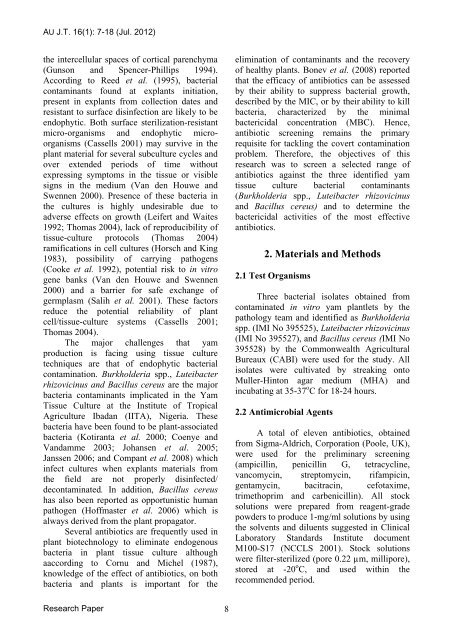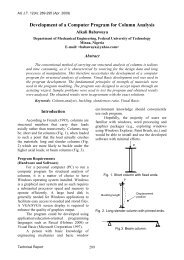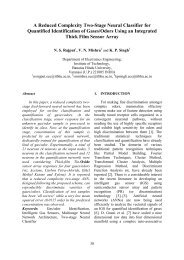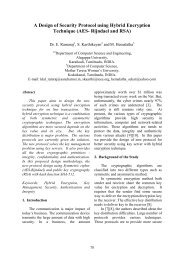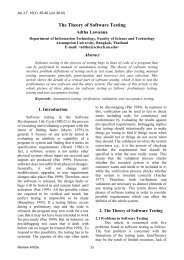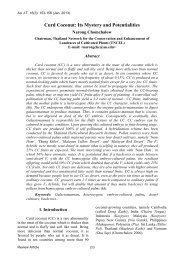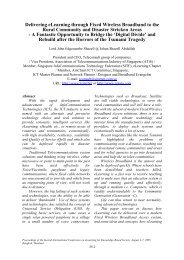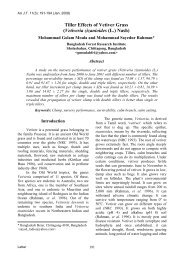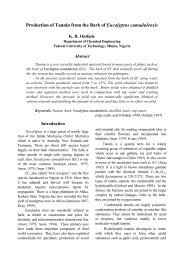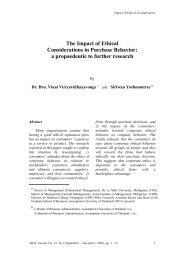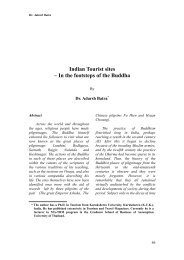Screening Antibiotics for the Elimination of Bacteria ... - AU Journal
Screening Antibiotics for the Elimination of Bacteria ... - AU Journal
Screening Antibiotics for the Elimination of Bacteria ... - AU Journal
You also want an ePaper? Increase the reach of your titles
YUMPU automatically turns print PDFs into web optimized ePapers that Google loves.
<strong>AU</strong> J.T. 16(1): 7-18 (Jul. 2012)<br />
<strong>the</strong> intercellular spaces <strong>of</strong> cortical parenchyma<br />
(Gunson and Spencer-Phillips 1994).<br />
According to Reed et al. (1995), bacterial<br />
contaminants found at explants initiation,<br />
present in explants from collection dates and<br />
resistant to surface disinfection are likely to be<br />
endophytic. Both surface sterilization-resistant<br />
micro-organisms and endophytic microorganisms<br />
(Cassells 2001) may survive in <strong>the</strong><br />
plant material <strong>for</strong> several subculture cycles and<br />
over extended periods <strong>of</strong> time without<br />
expressing symptoms in <strong>the</strong> tissue or visible<br />
signs in <strong>the</strong> medium (Van den Houwe and<br />
Swennen 2000). Presence <strong>of</strong> <strong>the</strong>se bacteria in<br />
<strong>the</strong> cultures is highly undesirable due to<br />
adverse effects on growth (Leifert and Waites<br />
1992; Thomas 2004), lack <strong>of</strong> reproducibility <strong>of</strong><br />
tissue-culture protocols (Thomas 2004)<br />
ramifications in cell cultures (Horsch and King<br />
1983), possibility <strong>of</strong> carrying pathogens<br />
(Cooke et al. 1992), potential risk to in vitro<br />
gene banks (Van den Houwe and Swennen<br />
2000) and a barrier <strong>for</strong> safe exchange <strong>of</strong><br />
germplasm (Salih et al. 2001). These factors<br />
reduce <strong>the</strong> potential reliability <strong>of</strong> plant<br />
cell/tissue-culture systems (Cassells 2001;<br />
Thomas 2004).<br />
The major challenges that yam<br />
production is facing using tissue culture<br />
techniques are that <strong>of</strong> endophytic bacterial<br />
contamination. Burkholderia spp., Luteibacter<br />
rhizovicinus and Bacillus cereus are <strong>the</strong> major<br />
bacteria contaminants implicated in <strong>the</strong> Yam<br />
Tissue Culture at <strong>the</strong> Institute <strong>of</strong> Tropical<br />
Agriculture Ibadan (IITA), Nigeria. These<br />
bacteria have been found to be plant-associated<br />
bacteria (Kotiranta et al. 2000; Coenye and<br />
Vandamme 2003; Johansen et al. 2005;<br />
Janssen 2006; and Compant et al. 2008) which<br />
infect cultures when explants materials from<br />
<strong>the</strong> field are not properly disinfected/<br />
decontaminated. In addition, Bacillus cereus<br />
has also been reported as opportunistic human<br />
pathogen (H<strong>of</strong>fmaster et al. 2006) which is<br />
always derived from <strong>the</strong> plant propagator.<br />
Several antibiotics are frequently used in<br />
plant biotechnology to eliminate endogenous<br />
bacteria in plant tissue culture although<br />
aaccording to Cornu and Michel (1987),<br />
knowledge <strong>of</strong> <strong>the</strong> effect <strong>of</strong> antibiotics, on both<br />
bacteria and plants is important <strong>for</strong> <strong>the</strong><br />
elimination <strong>of</strong> contaminants and <strong>the</strong> recovery<br />
<strong>of</strong> healthy plants. Bonev et al. (2008) reported<br />
that <strong>the</strong> efficacy <strong>of</strong> antibiotics can be assessed<br />
by <strong>the</strong>ir ability to suppress bacterial growth,<br />
described by <strong>the</strong> MIC, or by <strong>the</strong>ir ability to kill<br />
bacteria, characterized by <strong>the</strong> minimal<br />
bactericidal concentration (MBC). Hence,<br />
antibiotic screening remains <strong>the</strong> primary<br />
requisite <strong>for</strong> tackling <strong>the</strong> covert contamination<br />
problem. There<strong>for</strong>e, <strong>the</strong> objectives <strong>of</strong> this<br />
research was to screen a selected range <strong>of</strong><br />
antibiotics against <strong>the</strong> three identified yam<br />
tissue culture bacterial contaminants<br />
(Burkholderia spp., Luteibacter rhizovicinus<br />
and Bacillus cereus) and to determine <strong>the</strong><br />
bactericidal activities <strong>of</strong> <strong>the</strong> most effective<br />
antibiotics.<br />
2. Materials and Methods<br />
2.1 Test Organisms<br />
Three bacterial isolates obtained from<br />
contaminated in vitro yam plantlets by <strong>the</strong><br />
pathology team and identified as Burkholderia<br />
spp. (IMI No 395525), Luteibacter rhizovicinus<br />
(IMI No 395527), and Bacillus cereus (IMI No<br />
395528) by <strong>the</strong> Commonwealth Agricultural<br />
Bureaux (CABI) were used <strong>for</strong> <strong>the</strong> study. All<br />
isolates were cultivated by streaking onto<br />
Muller-Hinton agar medium (MHA) and<br />
incubating at 35-37 o C <strong>for</strong> 18-24 hours.<br />
2.2 Antimicrobial Agents<br />
A total <strong>of</strong> eleven antibiotics, obtained<br />
from Sigma-Aldrich, Corporation (Poole, UK),<br />
were used <strong>for</strong> <strong>the</strong> preliminary screening<br />
(ampicillin, penicillin G, tetracycline,<br />
vancomycin, streptomycin, rifampicin,<br />
gentamycin, bacitracin, cefotaxime,<br />
trimethoprim and carbenicillin). All stock<br />
solutions were prepared from reagent-grade<br />
powders to produce 1-mg/ml solutions by using<br />
<strong>the</strong> solvents and diluents suggested in Clinical<br />
Laboratory Standards Institute document<br />
M100-S17 (NCCLS 2001). Stock solutions<br />
were filter-sterilized (pore 0.22 µm, millipore),<br />
stored at -20 o C, and used within <strong>the</strong><br />
recommended period.<br />
Research Paper 8


